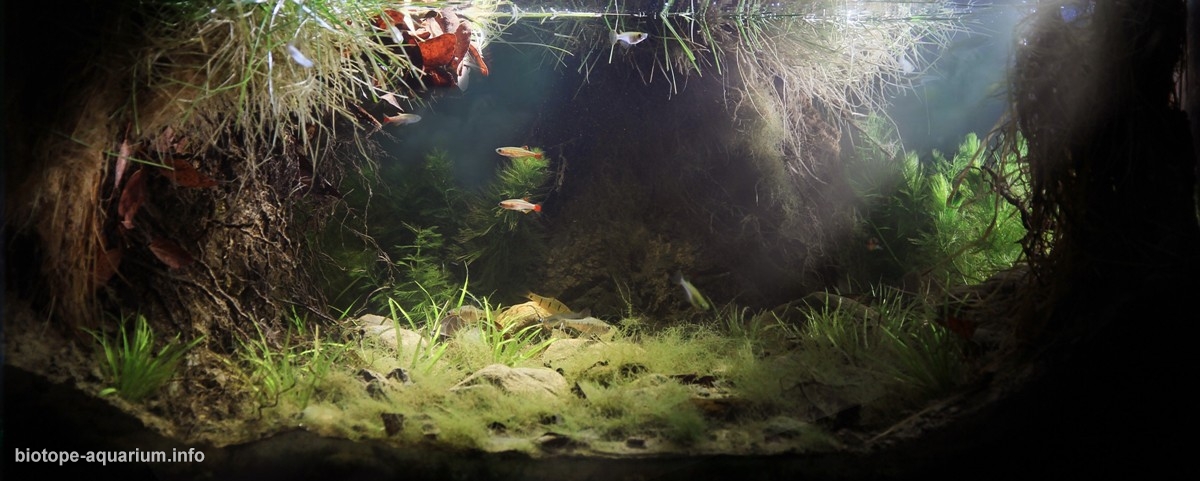Banks of Yangmei river in the dry season, Mount Zaomu, Foshan, China
9th place in Biotope Aquarium Design Contest 2019
China. Nan Li

Volume: 90 L
Dimensions: 60x50x30cm
List of fishes: Oryzias pectoralis, Tanichthys albonubes, Barbodes semifasciolatus
List of plants: Myriophyllum hippuroides, Blyxa japonica, Myriophyllum hippuroides (invasive)
Description of decorations: Tanichthys albonubes (Lin, 1932) is one of the most beautiful native fishes in China. Unfortunately, with the continuous expansion of human activities, the habitat is constantly being destroyed, and the wild population disappears a lot. In recent years, under the conservation of native guardians, the wild community is gradually recovering. In order to let more people understand their beauty and protect them, I plan to make a biotope aquarium to truly restore the habitat of Tanichthys albonubes this year. The first-hand materials are the basis of a good habitat restoration. I invited my friends in Guangdong province to collect useful information, e.g. videos, pictures and environmental parameters, of typical habitats of Tanichthys albonubes. My target is the Yangmei River which originated in Mount Zaomu in Foshan city. The water becomes clear and gentle during the dry season. The substrate is muddy, with scattered small rocks. The vegetation is rich. The roots and leaves of the terrestrial plants live on the river bank are naturally falling down to the water, forming a natural shelter for Tanichthys albonubes and other fish, where they can grow, play, and reproduce. All the materials used in my aquarium, including rocks, branches, dry leaves, etc., come from the wild nature. In order to restore wild habitat of Tanichthys albonubes in the most authentic way, I use the natural pond mud taking from the origin in Foshan, Guangdong Province, which is vital in producing beneficial bacteria and achieving the same water quality parameters as in the original habitat. I restored the banks of river using rocks and pond mud on the left side and the back of the aquarium, and planted a lot of grass on the banks. After a few months, the roots of these terrestrial plants grew underwater and extend all the way down, eventually firmly plunging into the bed. The leaves of the grass naturally fall into the water. After a long period of soaking, some of the leaves begin to turn yellow and become spoiled, providing a lot of shelters and foods for the fish. I planted a large number of Myriophyllum hippuroides (Nuttall ex Torrey & A. Gray 1840) under the river bank, and also some Blyxa japonica (Ascherson and Gurke, 1889) on the bottom. These aqua plants played an important role in maintaining water quality and ecological balance. They also provide the fish with a space to play and breed. A good ecosystem must consider not only the survival and reproductive needs for the adult fish, but also the needs for new born fish survival and growth. I used willow roots and fallen leaves to build a floating island connected with the river bank. As time passed, more and more dry leaves fell into the water and eventually gathered around the island, which effectively slow down the water flow. It also provides an ideal upper layer living space for the new born fish to escape from the attack. Two months after the floating island was built, the Oryzias pectoralis (T. R. Roberts,1998) succeeded in breeding in my aquarium. You can imagine the excitement when I saw the new born fish swimming in my aquarium. I made an interesting attempt in this small ecosystem. Two grasshoppers were caught from the wild, and they were kept in the grass on the bank, grazing and singing every day. The most interesting thing is to observe the grasshopper molting. The grasshopper slowly breaks free from the body and the wet body and soft wings are slowly dried, restore color and hardness, complete the growth. The entire process of molting will last for about an hour. These two grasshoppers have molted several times and have grown from larvae to adult worms. Looking forward to the succeed in breeding.
Description of equipment: Kessil Tuna Sun A160WE 40w LED lamp, Spectrum 6,000K to 9,000K. EHEIM 600 classic external filter (1000 L/H)
Water parameters: Aquarium water looks clear. The aquarium is kept at room temperature at about 25°C at this time of year. The parameters of the water are 6.5 pH and 7 GH. These pH and GH values are reached thanks to the use of the same substrate of the aquatic system.
Additional info: –
INFORMATION ABOUT BIOTOPE
Description of the area surrounding the biotope: The Yangmei River is originated in Mount Zaomu and cross through Yangmei Town, and flows into the Gaoming River in Renhe Town. Finally, it flows into West river which is one of the main streams of the Pearl River system in Guangdong Province. The Yangmei River is 39.43 kilometers long with a total drop of 805.2 meters and a rain collection area of 191.6 square kilometers. The rivers in the territory are intertwined, the plains account for 75% of the total area, and the hills account for 25% of the total area. Yangmei river is located in Foshan city which is in the central plain of the Pearl River Delta in Guangdong Province. Mount Zaomu is the first peak of Foshan City. It is 805.2 meters above sea level. The mountains are covered by large forests and the vegetation is flourishing. Wild animals such as wild boars and wild goats and many birds live in the mountains.
Description of the underwater landscape of the biotope: The Yangmei River has a relatively slow water flow in the dry season. The substrate at the bottom of the river is muddy with sand and rocks. Underwater vegetation is very rich. A large amount of Myriophyllum hippuroides are distributed (Myriophyllum hippuroides is invasive species in China, but at present they are very common in ponds and streams) in some specific course of the river. The aquatic plants, benthic animals and plankton are extremely rich. There are many upper, middle and lower layers of fish, and the ecological groups are more complicated. The roots of the land plants immersed into the water, together with branches providing abundant shelter and food sources for underwater life.
Description of the parameters of the habitat: Foshan belongs to the subtropical maritime monsoon climate. The coordinates of Mount Zaomu are 23°01′19′′N 113°07′15′′E. The annual average temperature is 22.5 °C. The annual precipitation is 1,681.2 mm, and the annual average sunshine is 1886.3 hours. The typhoon activity is frequent, and the rainfall could reach 79% of the year in the rainy season from April to September. During the rainy season, the water level rises obviously. The soil, branches and leaves along the river bank are washed into the river. The water level is reduced during the dry season (from October to March), and the organic matter content in the water is also reduced. The water becomes clear and gentle. The typical pH is 6.5 and GH is 6.8 during the dry season.
List of fishes and invertebrates occurring in the nature biotope: The Oryzias pectoralis (T. R. Roberts,1998) prefers to inhabit the upper layer of water, usually on top of the underwater plants near the river bank. Tanichthys albonubes (Lin, 1932), Rasbora steineri (Nichols et C. H. Pope, 1927), Aphyocypris normalis (Nichols & Pope, 1927) and Barbodes semifasciolatus (Günther, 1868) live in the middle and bottom of the water and prefer to shuttle among the underwater plants. Caridina cantonensis (Yu,1938) also lives in this river.
List of plants found in the nature biotope: Myriophyllum hippuroides (Nuttall ex Torrey & A. Gray 1840), associated with other underwater plants such as Blyxa japonica (Ascherson and Gurke, 1889) are found in the Yangmei River. The color of these plants is a little yellow due to lack of light. Myriophyllum hippuroides is invasive species in China, but at present they are very common in ponds and streams.
Threats to the ecology: Because the reproductive capacity of Tanichthys albonubes (Lin, 1932) is not strong, the population is small. In recent years, because of human activities, the destruction of mountain forests in the production areas, the soil was loss and the water was cut off or diverted. The ecological environment of the original distribution area of Tanichthys albonubes has changed greatly, which has made it difficult to find traces in nature. The theme I chose is to let more people understand Tanichthys albonubes and work together to protect them, so that this beautiful species can continue to flourish in nature.
Sources of information:
1. The freshwater fishes of Guangdong Province, Guangdong Science and Technology Press, P77, P138
2. A New Record Species of Ricefishes in China: Oryzias pectoralis, Wu Wei-ming, Li Jian-Zhong
3. Threatened fishes of the world: Tanichthys albonubes Lin 1932 (Cyprinidae), Xu-Fang Liang, Guo-Zhu Chen, Xiang-Lin Chen
4. Gentle stream of Yangmei river, Mount Zaomu, Foshan, China, Li Nan, https://mp.weixin.qq.com/s?__biz=MzU2OTg2NjgyMw==&mid=2247484841&idx=1&sn=d7cb6a70dcc8ccc2fc8bf9941f0cba1f&chksm=fcf96a81cb8ee397c9dbfc2f0b741c9431e7bed5bc775001ed2b6dfde0f9b427d9ed2178bcaf&token=667811672&lang=zh_CN#rd
Comments of the members of the jury of Biotope Aquarium Design Contest 2019

For these fish species, we are used to seeing pure biotopes without plants, only with rocks and sand, so this biotop is a nice change. The depth that is created is fantastic, as is the impression of naturalness with roots bending over the edges of the aquarium. Because of the play of light and shadow, it is difficult to say whether it is an aquarium or a shot from nature.

How I went over and over this tank trying to find some fault, but there was none. This tank was a flawless ten for me, and it has everything: a wonderful wide open space for the minnows to browse; surface foliage to shield the Oryzias; considered lighting with ample shadows for confidence boosting; even a grazing area exploited by the Golden barbs. This strikes me as one of those ‘Gaia’ set-ups — the more the aquarist leaves it to its own devices, the more suitable it becomes for the inhabitants, evolving into a sprawling but closed ecosystem.

Congratulation to author for so nice natural aquarium. Congratulation for very interesting video with special music. Arrangement, video and fantastic music create the impression of being in the natural environment. All details of setup are precisely matched and form a scrap of nature. It is one with my favorites aquariums.

A perfect play of shadow and light, also the whole setting its giving a wonderful impression of the habitat.

This work is also striking in its realism. It’s nice to see wild fishes in the aquarium, not farm-raised ones. You can immediately see that the fishes like it here.

It is an impressive aquarium. The simulation of the river’s margins with the roots entering the water looks so real. And the algae in the background complement the natural scenery. The play of light is also very good. Congratulations, well done!

You feel the balance in this setup. Interesting information on the habitat of one of my favorite fishes (Tanichthys albonubes). A limited amount of fish in this tank, how it should be in a low maintenance tank. Very natural algae display and an attractive depth in the aquarium. Excellent biotoping job!

It seems to me that the aquatic plants were planted recently, and have not reached the best form, but it is a nice work without doubt. The ecosystem in this tank was well designed, with compatible species composition, suitable quantity, and natural views.
